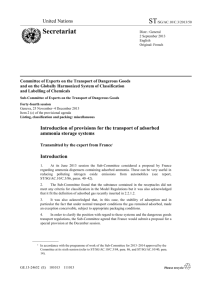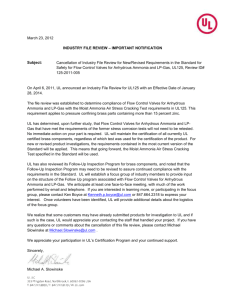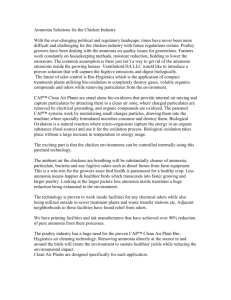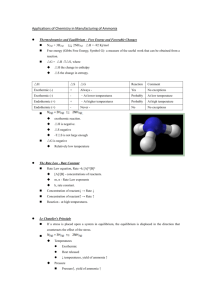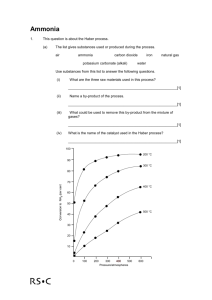1321580
advertisement
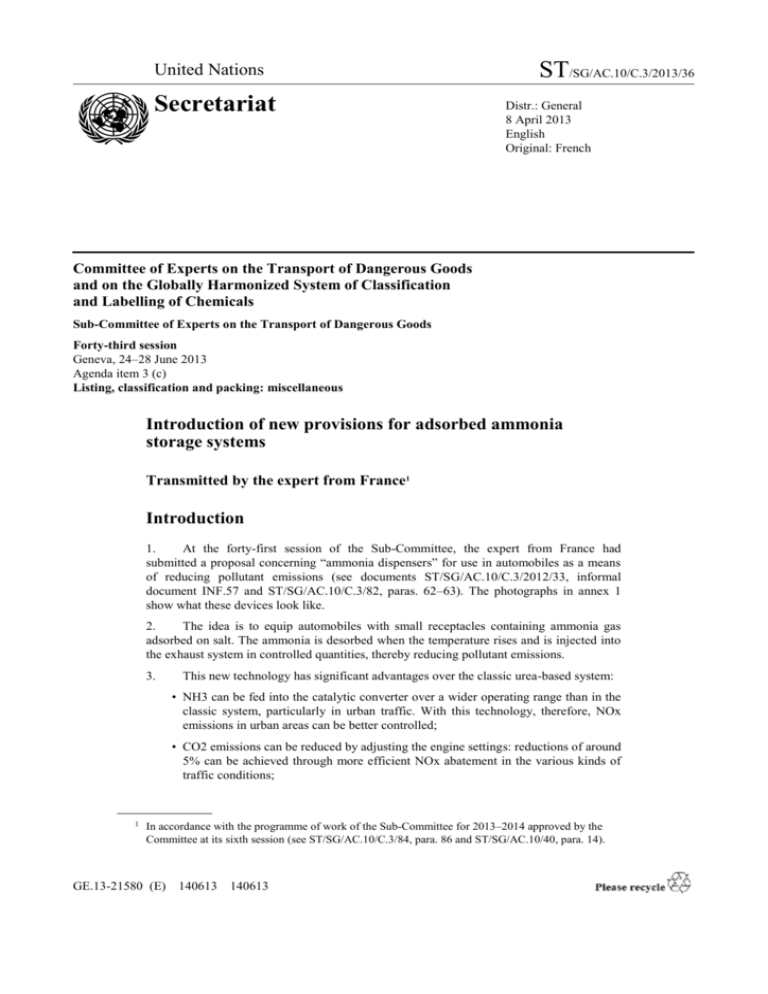
United Nations Secretariat ST/SG/AC.10/C.3/2013/36 Distr.: General 8 April 2013 English Original: French Committee of Experts on the Transport of Dangerous Goods and on the Globally Harmonized System of Classification and Labelling of Chemicals Sub-Committee of Experts on the Transport of Dangerous Goods Forty-third session Geneva, 24–28 June 2013 Agenda item 3 (c) Listing, classification and packing: miscellaneous Introduction of new provisions for adsorbed ammonia storage systems Transmitted by the expert from France1 Introduction 1. At the forty-first session of the Sub-Committee, the expert from France had submitted a proposal concerning “ammonia dispensers” for use in automobiles as a means of reducing pollutant emissions (see documents ST/SG/AC.10/C.3/2012/33, informal document INF.57 and ST/SG/AC.10/C.3/82, paras. 62–63). The photographs in annex 1 show what these devices look like. 2. The idea is to equip automobiles with small receptacles containing ammonia gas adsorbed on salt. The ammonia is desorbed when the temperature rises and is injected into the exhaust system in controlled quantities, thereby reducing pollutant emissions. 3. This new technology has significant advantages over the classic urea-based system: • NH3 can be fed into the catalytic converter over a wider operating range than in the classic system, particularly in urban traffic. With this technology, therefore, NOx emissions in urban areas can be better controlled; • CO2 emissions can be reduced by adjusting the engine settings: reductions of around 5% can be achieved through more efficient NOx abatement in the various kinds of traffic conditions; 1 In accordance with the programme of work of the Sub-Committee for 2013–2014 approved by the Committee at its sixth session (see ST/SG/AC.10/C.3/84, para. 86 and ST/SG/AC.10/40, para. 14). GE.13-21580 (E) 140613 140613 ST/SG/AC.10/C.3/2013/36 • The space required to mount the system is cut by 50%. The total weight of the system is also halved, which has a direct impact on consumption and emissions. 4. The original proposal was to add a new entry to Class 9 defining a specific article as an “ammonia dispenser”. 5. The French expert has however noted the Sub-Committee’s comments and the developments regarding adsorbed gases following the adoption, at the forty-second session, of special UN Nos. for the transport of such gases (see document ST/SG/AC.10/C.3/84, para. 29). 6. In light of that decision it seemed more logical to apply the recently adopted provisions to the transport of these systems, which contain adsorbed ammonia. 7. However, those provisions did not include a specific entry for ammonia, which would mean applying a generic entry such as “ADSORBED GAS, TOXIC, CORROSIVE, N.O.S.”. Problem relating to adsorption of gases 8. In the provisions adopted in December 2012, an adsorbed gas is defined as a gas adsorbed onto a solid porous material resulting in an internal receptacle pressure of less than 101.3 kPa at 20°C and less than 300 kPa at 50°C. 9. The values applied here correspond to adsorption bonds of minimum solidity. Depending on the gas and the adsorbent used, the bond can be much more solid, giving a degree of stability such that the adsorption could in itself be seen as a gas-retention barrier that would be effective enough to permit the use of receptacles with different characteristics from those specified in the new packaging instructions. 10. A good indicator of the stability of adsorption is the temperature at which the gas will be released and pressure levels reached as the temperature rises. 11. The graph in annex 2 shows, from lowest to highest, the vapour pressure curves for: Green and orange-red (a) 10% ammonia solution; (b) 25% ammonia solution (UN 2672 Class 8); (c) 35% ammonia solution (UN 2672 Class 8); (d) 50% ammonia solution (UN 2073 Class 2); (e) Anhydrous ammonia (UN 1005 Class 2); (f) The temperature/pressure curve for ammonia adsorbed on strontium chloride Blue salts. 12. This shows that the adsorption bond here is much more stable than that envisaged when the new entries on adsorbed gases were adopted. 13. In particular: (a) The equilibrium pressure of adsorbed ammonia is in this case 0.5 bar at 20°C; (b) Gas release starts only at temperatures above 40°C; (c) The vapour pressure curve remains below that of ammonia solution, yet ammonia solution is classed as a corrosive liquid and authorized for transport in packagings 2 GE.13-21580 ST/SG/AC.10/C.3/2013/36 — or even, in certain conditions, in IBCs — up to temperatures higher than those normally found in transport operations. 14. In addition, the mechanical resistance properties resulting from the application of these standards, and the test pressure and burst pressure values specified for all adsorbed gases generally (i.e., 21 bar and 94.5 bar respectively) are higher than those specified for receptacles intended to contain anhydrous ammonia itself or Class 2 highly concentrated ammonia solutions. 15. The direct application of the new provisions for adsorbed gases to this particular case would therefore result in more stringent conditions being set for adsorbed gases than for ammonia itself or for Class 2 ammonia solutions, whereas, provided certain conditions are met, adsorbed gas is a lower risk than a Class 8 ammonia solution, provided the temperature does not go over 70°C (a value not usually exceeded under normal transport conditions). 16. This illogical situation can only discourage the industry from developing innovative solutions that are safer than the use of anhydrous ammonia. Proposal 17. The French expert offered to draft provisions on this particular case and submit them for the Sub-Committee’s approval. 18. These provisions should, on the one hand, contain simplified rules for the transport and design of the receptacles and, on the other, specify the scope of the provisions, including standards for the stability of adsorption. 19. The French expert said that he had noted the Subcommittee’s reluctance to adopt special entries for every single case, but two options might be considered: (a) Option 1: Using the generic entry referred to in paragraph 7 above and establishing specific conditions in a special provision; (b) Option 2: Creating a new entry such as “Storage of ammonia on an adsorbent” and establishing suitable conditions in the relevant parts of the Model Regulations. Naturally, transport of adsorbed ammonia falling outside the scope of these provisions (e.g., by virtue of the stability of their adsorption bonds) should continue to be carried out in accordance with the general provisions adopted for the transport of adsorbed gases. 20. The Sub-Committee is invited to take a decision on its preferred option in order to facilitate drafting. 21. The French expert will transmit detailed technical data as a supplement to this document, and test results as an information document. GE.13-21580 3 ST/SG/AC.10/C.3/2013/36 Annex I Individual receptacle and assembled system for mounting in a vehicle Receptacle and assembled system for mounting in a vehicle. 4 GE.13-21580 10% ammonia solution ST/SG/AC.10/C.3/2013/36 Annex II 10% ammonia solution 25% ammonia solution 35% ammonia solution 50% ammonia solution NH3 adsorbed on strontium chloride salts Extrapolation Anhydrous ammonia GE.13-21580 5


